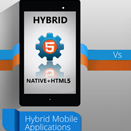

These days, smartphones are more than just phones- they are disruptive, networked multimedia devices, and in the years to come they will get even more advanced. One of the most important features of smartphones is mobility and it has definitely changed our lives for good. It has influenced the way we conduct business, communicate and collaborate. According to a recent finding, it has been estimated that around 62% of all digital media time is now spent on mobile and 80% of this time is spent on mobile apps.
Is Your Business Prepared For The Mobile App Revolution?
Your customers are always on the move, and they are increasingly becoming dependant on mobile application to get what they want. Be it smartphone, tablet or mobile, no matter the device they use, they have all the information they need and the world is at their fingertips. In today’s competing business environment, can your business continue to avoid mobile apps? A big NO, isn’t it?
So, now that you agree that your business definitely needs a mobile app, let’s delve deeper and understand what all goes into mobile app development.
There are many factors than can influence your mobile strategy, like the device functionality required by you, your team’s app development skills, interoperability and lot more. App development is never about what you want your app to do, but it is about how you are going to make it do that.
A lot of trial and error might be involved in your app development process to find the perfect match. However, at times you might not be as lucky, since each app development scenario has its own pros and cons.
Options Available For Mobile App Development
The first step in the app development processes is to decide what kind of app will work best for you. The options available for app development are – native, hybrid or HTML5 app.
- Native apps are mobile platform specific. Since, a native app is built for a particular platform they can use platform specific development tools and languages such as Objective C for iOS and Java for Android. Native apps have great performance and looks.
- HTML5 apps are built using HTML, CSS and JavaScript. A well written HTML5 app can facilitate interoperability across multiple platforms. While it is possible for developers to develop highly sophisticated mobile apps with HTML5, some limitations might still remain at the time of writing, specifically concerning secure offline storage, access to functionality of native devices such as calendar, camera, geolocation, etc.
- Hybrid apps allow embedding of HTML5 apps inside a native app, combining the best elements of both native as well as HTML5 apps.
Native Mobile Applications
Native apps provide best features, great user experience as well as usability. There are certain characteristics that can be found in native apps.
- Multi Touch – Compound UI gestures such as double taps, pinch-spread, etc.
- Fast Graphics Application Program Interface (API) – Native platform enables fast graphics, which is helpful in fast refreshing when using huge volumes of data.
- Fluid Visual Effects– Fast graphics API helps in creating fluid animation effects. This is crucial in gaming, performing highly computational algorithms for converting photos, etc.
- Built-In Components – Features that are native to the platform can be easily integrated into native mobile app such as address book, camera, etc.
- Familiarity & Ease Of Use – People are familiar with native platform so when you incorporate native features, you have an app that is familiar to users and is hence easy-to-use.
- Documentation – There are more than 2500 books alone on Android and iOS app development available apart from articles, blogs, and other detailed technical content that can aid in mobile app development.
Native apps are generally built using an Integrated Development Environment (IDE), which provides tools for developing, project management, debugging along with other tools required by professional developers. These tools are required because native tools are not easy to develop. The level of experience required for native app development is also higher. Apart from these development benefits, native apps are also beneficial to the end user. These apps can be easily searched in app stores, can fire up right away, provide fast performance as well as consistent look and feel.
HTML5 Mobile Applications
HTML5 apps are interoperable across platforms and can be opened using any modern mobile browser. Since, the content is available on the web it is searchable, which can be really beneficial to any business. For new web developers, it is comparatively easier to get started with than native or hybrid app development. Distribution and support for HTML5 is also comparatively easier than native apps. Native apps have longer development and testing cycles and the customer has to download the latest version to get the latest bug fixes.
HTML5 is replacing Flash for creation of interactive eBooks and is also emerging as a preferred choice for building mobile applications. For enhanced banners and flash in-page creatives, mobile and app development agencies should make the switch from Flash to HTML5. HTML5 apps are surely easier to develop and facilitate interoperability, however it may have a few limitations like the users won’t be familiar with the look and feel of the app and the native features of the device can’t be accessed. Presently, efforts are being made to support as much functionality as possible on all browsers.
Hybrid Mobile Applications
Hybrid app development takes into account the best of both native and HTML5 apps. Developers can optimize JavaScript, use CSS to create amazing layouts and write HTML codes that work on any platform without having to sacrifice the native capabilities. As you know native apps are installed on a device whereas HTML5 apps are available on a web server, hybrid apps can be implemented in two ways.
- Local – HTML and JavaScript code can be packaged inside the mobile app binary, to make the structure similar to that of native application. In such cases REST APIs are used to move data between device and the cloud.
- Server – Alternatively, full web application can be implemented from the server, by using the container as a thin shell above the UIWebView.
For more information on Native, Hybrid or HTML5 mobile app development, please write to us at info@suntecindia.com and our experts will get back to you shortly.

